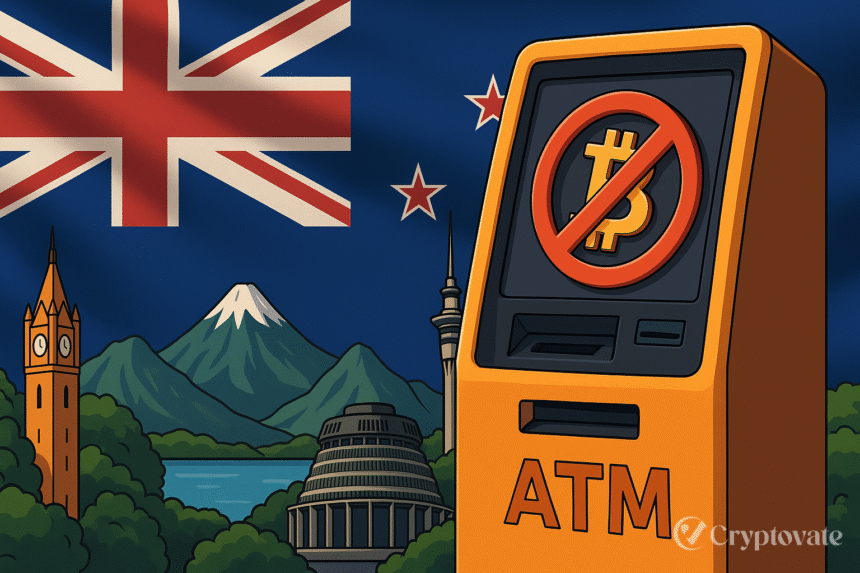– Ad –
| Getting your Trinity Audio player ready... |
On July 9, 2025, New Zealand introduced sweeping measures to combat money laundering and organized financial crime, including a nationwide ban on cryptocurrency ATMs and a $5,000 limit on international cash transfers. These reforms, announced by Associate Justice Minister Nicole McKee, signal a robust approach to tightening the country’s Anti-Money Laundering and Countering Financing of Terrorism (AML/CFT) framework. This article explores the details of these measures, their implications for the crypto industry, and how they align with global trends.
The Crypto ATM Ban
New Zealand’s ban affects around 220 crypto ATMs located in small supermarkets, convenience stores, vape shops, gas stations, and laundromats. These machines, which allow users to convert cash into cryptocurrencies like Bitcoin, have been flagged as high-risk for money laundering. Criminals often exploit their anonymity to funnel illicit funds into digital assets, facilitating activities such as drug trafficking and scam operations.
The decision to ban crypto ATMs reflects growing concerns about their unregulated nature. Unlike traditional banking channels, crypto ATMs often charge high conversion fees (5-10%) and require minimal identity verification, making them attractive to those seeking to obscure the origins of their funds. By eliminating these machines, New Zealand aims to close a significant loophole in its financial oversight system.
$5,000 Cash Transfer Limit
In addition to the ATM ban, New Zealand has imposed a $5,000 cap on international cash transfers through money transfer services. This measure targets cash-based transactions, which are harder to trace than electronic bank transfers. Legitimate transfers exceeding $5,000 can still be conducted via bank accounts, ensuring compliance with AML/CFT regulations. The cap is designed to deter criminals from moving large sums of cash across borders, a common tactic in money laundering and terrorism financing.
Also Read: Singapore’s $3B Money Laundering Scandal: Banks and Crypto Under Fire
Broader AML/CFT Reforms
The crypto ATM ban and cash transfer limit are part of a broader overhaul of New Zealand’s AML/CFT regime. Key components include:
- Enhanced Enforcement Powers: Police and regulatory bodies will gain expanded authority to investigate and prosecute financial crimes.
- Improved Financial Surveillance: The Financial Intelligence Unit will strengthen its monitoring of suspicious transactions.
- Proposed Industry Levy: A new funding model will support the AML/CFT framework, potentially shifting costs to financial institutions.
These reforms aim to align New Zealand with international standards set by the Financial Action Task Force (FATF), ensuring the country remains a leader in combating financial crime.
Industry and Global Context
Industry leaders in New Zealand’s crypto sector have responded cautiously, acknowledging the high fees and risks associated with crypto ATMs. Some argue that the ban could push legitimate users toward less regulated platforms, but most agree that curbing illicit activity is a priority. Globally, New Zealand’s move mirrors actions in countries like Australia, which restricted crypto ATM operations, and the UK, where many ATMs operate without proper licensing.
The global crypto ATM market has faced increasing scrutiny. In 2024, Australia reported a surge in scams linked to crypto ATMs, prompting similar regulatory crackdowns. New Zealand’s proactive stance positions it as part of a broader trend to regulate digital assets more stringently.
Implications for New Zealand
The ban and cash limit will likely reshape New Zealand’s financial landscape. Crypto users may shift to online exchanges, which are subject to stricter KYC (Know Your Customer) requirements. Small businesses hosting ATMs may face revenue losses, but the broader economy could benefit from reduced financial crime. The $5,000 cash transfer cap may inconvenience some legitimate users, but electronic banking options provide a viable workaround.
Also Read: Crypto KYC Explained: Why You Need It in 2025 and How to Do It
Conclusion
New Zealand’s ban on crypto ATMs and $5,000 cash transfer limit mark a significant step in its fight against money laundering and financial crime. By targeting high-risk channels like crypto ATMs and unregulated cash transfers, the government aims to safeguard its financial system while aligning with global standards. As the crypto industry evolves, these measures highlight the delicate balance between innovation and regulation, ensuring that New Zealand remains a secure and trustworthy financial hub.
FAQs
Why has New Zealand banned cryptocurrency ATMs?
New Zealand has prohibited crypto ATMs to tackle money laundering and financial crimes. These machines allow anonymous cash-to-crypto conversions, making them attractive for illicit activities like drug trafficking and scams.
How many crypto ATMs are affected by the ban?
Approximately 220 crypto ATMs across New Zealand, found in places like supermarkets, vape shops, and laundromats, are impacted by the ban announced on July 9, 2025.
What is the $5,000 cash transfer limit?
The $5,000 limit applies to international cash transfers via money transfer services to prevent untraceable cash movements. Transfers above $5,000 can be made electronically through banks.
Can I still use cryptocurrencies in New Zealand?
Yes, cryptocurrencies can be used via online exchanges, which follow stricter Know Your Customer (KYC) regulations. The ban only targets physical crypto ATMs.
How does New Zealand’s crypto ATM ban compare to measures in other countries?
New Zealand’s ban aligns with global trends. Australia has restricted crypto ATM operations due to scams, and the UK has cracked down on unlicensed ATMs, reflecting similar AML/CFT priorities.

















